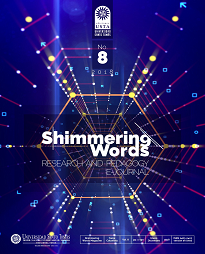Hombre, lenguaje y comunicación a través del tiempo
Contenido principal del artículo
Resumen
El desarrollo del hombre está directamente ligado al desarrollo del lenguaje, su relación implica una transacción de saberes, ideas y conceptos que modifican la sociedad de la cual hace parte; el presente escrito da una visión de la evolución del lenguaje a través del tiempo, la importancia de la comunicación en el mundo moderno y la adquisición de un segundo idioma (inglés) como herramienta para enfrentar los avances e implicaciones de la globalización.
Igualmente, se abordan conceptos pertinentes a la relevancia del lenguaje en términos de capital económico, cultural, social, simbólico y lingüístico y de cómo estos temas determinan el progreso de una comunidad en el campo educativo.
Igualmente, se abordan conceptos pertinentes a la relevancia del lenguaje en términos de capital económico, cultural, social, simbólico y lingüístico y de cómo estos temas determinan el progreso de una comunidad en el campo educativo.
Detalles del artículo
Cómo citar
Alba Guío, F. E., & Escarria Carrillo, B. E. (2019). Hombre, lenguaje y comunicación a través del tiempo. Shimmering Words: Research and Pedagogy E-Journal, 8, 161-176. Recuperado a partir de http://revistas.ustatunja.edu.co/index.php/shimmering/article/view/1804
Sección
Artículos-8
Citas
Bank for International Settlements, (2008). Range of Practices and Issues in
Economic Capital Frameworks. Press & Communications. Retrieved from: https://www.bis.org/publ/bcbs152.pdf
Bourdieu, P. (1985). Sozialer Raum und Klassen, Ffm (Suhrlamp.)
Chardenet, P. (2012). El capital (inter)lingüístico como determinante de las
movilidades espaciales y virtuales. Retrieved from: file:///C:/Users/USUARIO/Downloads/articulo-obsmac_chardenet-11-12%20(1).pdf
Ciuffani, B. (2017). Non- verbal Communication and Leadership. The impact of hand gestures used by leaders on follower job satisfaction. University of Twente. Netherlands. Retrieved from: file:///C:/Users/Docentes/Documents/Thesis_%20Bianca_%20Ciuffani_s1108905.p
Damerow, P. (2006). The origins of Writing as a problem of Historical.
Epistemology. Cuneiform Digital Library Journal. Max Plank Institute for the History of Science, Berlin. https://cdli.ucla.edu/files/publications/cdlj2006_001.pdf file:///C:/Users/Docentes/Downloads/2523-Texto%20del%20art%C3%ADculo-|8746-2-10-20131213.pdf file:///C:/Users/USUARIO/Downloads/article%20CARMEN%20HELENA%20GU|ERRERO.pdf
Ginsburgh, V., Ortuño-Otín and Weber, S. (2006). Learning Foreign Languages. Theoretical and Empirical Implication of the Selten and Pool Model. JEL Classification Numbers: C72, O52, Z13. Retrieved from: file:///C:/Users/USUARIO/Downloads/learning.pdf
Guerrero, C. (2010). Is English the key to access the wonders of the modern world? A Critical Discourse Analysis. Revista Javeriana. Signo y Pensamiento 57. Documentos de Investigación. Vo XXIX.
Guerrero, C. (2010). Is English the key to access the wonders of the modern
world? A Critical Discourse Analysis. Signo y Pensamiento, documentos de investigación, XXIX. Pp. 294-313. Bogotá Colombia. Revista Universidad Javeriana. Retrieved from: https://repozytorium.amu.edu.pl/bitstream/10593/11301/1/Communication_History_and_Its_Research_Subject.pdf
Jackendoff, R. (2006). How did Language begin? Linguistic Society of America. Retrieved from: https://www.linguisticsociety.org/sites/default/files/LanguageBegin.pdf
Kulczycki, E. (2011). Communication History and its Research Subject. National Science Centre. University of Poznan, Poland.
McWhorter, J. (2004). The Story of Human Languages Part I. Manhattan Institute. The Teaching Company. Retrieved from: https://www.emse.fr/~bsimon/documents%20p%E9dagogiques/p%E9dagogie/The
Muchemwa, S. (2013) (PDF) Use of Nonverbal Communication in the Classroom as a Way of Enhancing Classroom Teaching: A Case Study of Solusi High School, Zimbabwe.Prodedia, Social and Behavioral Science. Research-gate. Retrieved from: https://www.researchgate.net/publication/270848476/download
Olson, D. (2009). The History of Writing. Retrieved from: https://www.sagepub.com/sites/default/files/upm/binaries/27267_5276_Beard_Ch01.pdf
Rehfeld, D. (2008). Dimensions of Symbolic Capital, Modes of Distinctiveness of European city Regions Under Change. University of Applied Science Gelsenkirchen / Ruhr University Bochum. Retrieved from: https://www.iat.eu/aktuell/veroeff/2008/rehfeld01.pdf
Rubingh, M. (2017). Japanese Communicative English and English as a Lingua Franca. Retrieved from: https://openaccess.leidenuniv.nl/bitstream/handle/1887/52262/Mick%20Rubingh%0s1060953%20Master%20Thesis%20v1.0.pdf?sequence=2
Trimmnel lE. (2005). Why You Need a Foreign Language & How to Learn One: Second Edition 2nd Edition.
Economic Capital Frameworks. Press & Communications. Retrieved from: https://www.bis.org/publ/bcbs152.pdf
Bourdieu, P. (1985). Sozialer Raum und Klassen, Ffm (Suhrlamp.)
Chardenet, P. (2012). El capital (inter)lingüístico como determinante de las
movilidades espaciales y virtuales. Retrieved from: file:///C:/Users/USUARIO/Downloads/articulo-obsmac_chardenet-11-12%20(1).pdf
Ciuffani, B. (2017). Non- verbal Communication and Leadership. The impact of hand gestures used by leaders on follower job satisfaction. University of Twente. Netherlands. Retrieved from: file:///C:/Users/Docentes/Documents/Thesis_%20Bianca_%20Ciuffani_s1108905.p
Damerow, P. (2006). The origins of Writing as a problem of Historical.
Epistemology. Cuneiform Digital Library Journal. Max Plank Institute for the History of Science, Berlin. https://cdli.ucla.edu/files/publications/cdlj2006_001.pdf file:///C:/Users/Docentes/Downloads/2523-Texto%20del%20art%C3%ADculo-|8746-2-10-20131213.pdf file:///C:/Users/USUARIO/Downloads/article%20CARMEN%20HELENA%20GU|ERRERO.pdf
Ginsburgh, V., Ortuño-Otín and Weber, S. (2006). Learning Foreign Languages. Theoretical and Empirical Implication of the Selten and Pool Model. JEL Classification Numbers: C72, O52, Z13. Retrieved from: file:///C:/Users/USUARIO/Downloads/learning.pdf
Guerrero, C. (2010). Is English the key to access the wonders of the modern world? A Critical Discourse Analysis. Revista Javeriana. Signo y Pensamiento 57. Documentos de Investigación. Vo XXIX.
Guerrero, C. (2010). Is English the key to access the wonders of the modern
world? A Critical Discourse Analysis. Signo y Pensamiento, documentos de investigación, XXIX. Pp. 294-313. Bogotá Colombia. Revista Universidad Javeriana. Retrieved from: https://repozytorium.amu.edu.pl/bitstream/10593/11301/1/Communication_History_and_Its_Research_Subject.pdf
Jackendoff, R. (2006). How did Language begin? Linguistic Society of America. Retrieved from: https://www.linguisticsociety.org/sites/default/files/LanguageBegin.pdf
Kulczycki, E. (2011). Communication History and its Research Subject. National Science Centre. University of Poznan, Poland.
McWhorter, J. (2004). The Story of Human Languages Part I. Manhattan Institute. The Teaching Company. Retrieved from: https://www.emse.fr/~bsimon/documents%20p%E9dagogiques/p%E9dagogie/The
Muchemwa, S. (2013) (PDF) Use of Nonverbal Communication in the Classroom as a Way of Enhancing Classroom Teaching: A Case Study of Solusi High School, Zimbabwe.Prodedia, Social and Behavioral Science. Research-gate. Retrieved from: https://www.researchgate.net/publication/270848476/download
Olson, D. (2009). The History of Writing. Retrieved from: https://www.sagepub.com/sites/default/files/upm/binaries/27267_5276_Beard_Ch01.pdf
Rehfeld, D. (2008). Dimensions of Symbolic Capital, Modes of Distinctiveness of European city Regions Under Change. University of Applied Science Gelsenkirchen / Ruhr University Bochum. Retrieved from: https://www.iat.eu/aktuell/veroeff/2008/rehfeld01.pdf
Rubingh, M. (2017). Japanese Communicative English and English as a Lingua Franca. Retrieved from: https://openaccess.leidenuniv.nl/bitstream/handle/1887/52262/Mick%20Rubingh%0s1060953%20Master%20Thesis%20v1.0.pdf?sequence=2
Trimmnel lE. (2005). Why You Need a Foreign Language & How to Learn One: Second Edition 2nd Edition.

